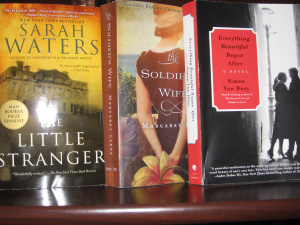Erika Robuck's Blog, page 25
December 22, 2011
Review: Diamond Ruby
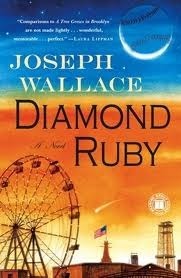
Joseph Wallace's novel, Diamond Ruby, was published in May of 2010 and is 459 pages. It was a nominee for Goodreads Best of 2010 Historical Fiction and it was an Indiebound Next Pick. I purchased a signed copy from Joe's local indie bookseller, The Village Bookstore in Pleasantville, N.Y., in support of #IndieThursday on Twitter, and after finishing it, I am so happy to have my own signed copy for my bookshelf. I absolutely loved it.
Set in the twenties in New York City, Diamond Ruby is the story of a young woman thrust into the role of caregiver for her family after the devastating Spanish influenza epidemic. With a combination of fierce love for her nieces, stubbornness, and a baseball pitch as good as any Major League player, Ruby manages to take care of her family, shatter stereotypes, and inspire suffragists by playing in an all male league.
It doesn't take long, however, for predators from the KKK, to Prohibition rumrunners, to gangsters to figure out how to exploit Ruby's vulnerability. With the help of her family, her friends, and Babe Ruth himself, however, Ruby becomes a formidable force for more than just the opposing teams.
Diamond Ruby is an excellent period piece. Wallace brilliantly balances history and prose, and connects his readers to the time by involving his characters in the events of historical importance. While I had a surface knowledge of the Spanish influenze epidemic, I had no idea how quickly it destroyed those who caught it. I was fascinated to learn about the beginnings of the Coney Island Boardwalk, disturbed to read about the prevalence of the KKK in New York at the time, and amazed that I'd never realized how vulnerable sports players could be to gambling and illegal activity.
Diamond Ruby is one of the few books where the light at the end of the tunnel is impossible to see and the ending, equally impossible to guess. The suspense and narrative tensions reach full throttle by the last third of the book, and readers will be unable to put it down. I don't want to reveal anything to you about the ending of Diamond Ruby, but you should know that I laughed, I cried, and I cheered.
Inspired by the true story of Jackie Mitchell–the girl who struck out Babe Ruth–Diamond Ruby is a fine piece of historical fiction by a fine writer. I give this book my highest recommendation.








December 16, 2011
My Favorite Books of 2011
Here are my top ten favorite reads of 2011 (though not all of them were published this year.) As usual, choosing my top reads was an agonizing task full of much internal debate, additions, deletions, momentary decisions to expand the list beyond ten, or break it into categories. In the end, I decided that I simply had to pick my favorites–the books I gift often, I reread, or that have somehow changed my view of the world, or fiction, or both.
All of the books are either historical fiction or straddle time periods, and all are exquisite. I linked my reviews of the novels to their titles if you'd like more information about them.
Without further ado, and in no particular order…
The Paris Wife, by Paula McLain
A Good Hard Look, by Ann Napolitano
Those Who Save Us, by Jenna Blum
A Secret Kept, by Tatiana de Rosnay
Everything Beautiful Began After, by Simon Van Booy
Letters From Home, by Kristina McMorris
The Soldier's Wife, by Margaret Leroy
Rules of Civility, by Amor Towles
The Distant Hours, by Kate Morton
The Little Stranger, by Sarah Waters
I'd love to hear if any of these novels made your top ten lists. If not, tell me your favorite reads of 2011.








December 12, 2011
Review: THE STORMCHASERS
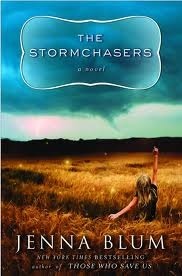
"Karena's whole body flushes hot, then cold. She sits on the edge of her desk and looks around the little white room, as if somebody else is there to confirm that yes, this is it. The call. The call she's been expecting, rehearsing for, dreading for twenty years.
'Yes, I have a brother Charles,' she says. 'He's my twin. Is everything all right?'"
The Stormchasers, Jenna Blum
The Stormchasers, by Jenna Blum, was published in 2010 and is 369 pages. I wanted to read this novel because I loved Blum's earlier novel, Those Who Save Us, about a German woman during the Nazi occupation. I was also intrigued by the premise of The Stormchasers, about adult twins torn apart by a terrible secret from their past and reunited in Tornado Alley. The novel was every bit as fascinating as I'd hoped.
When The Stormchasers begins, Karena Jorge is turning 38, but in spite of her newspaper job and close friends, her life feels empty. She feels the vacancy of her separation from her bipolar, storm-chasing twin, Charles. Before the day is over, she gets the call she's been anticipating for years–a psychiatric ward in Kansas contacts her looking for the family of a man who has just checked in. Once Karena is able to get to the hospital, her brother is gone, but she is determined to find him. Karena convinces her newspaper to send her on assignment with a group of storm chasers for a story, while she searches for Charles.
From the danger and thrill of chasing tornadoes, to the beginnings of a love affair, Karena gets more than she bargained for at every stop. When her past collides with her present, she finds that the only way around the storm is straight through it.
I read The Stormchasers in four nights. Blum's descriptions of turbulent weather are riveting, frightening, and invigorating, and her family narrative is every bit as rich. The setting and plot are unique and unpredictable, and the ending is very satisfying. Blum does a brilliant job of giving characters redemption without letting anyone off the hook, which to me, makes the best kind of ending.
While Blum's earlier novel, Those Who Save Us, was very different from The Stormchasers, both utilize a split time period narrative structure, memorable characters, and descriptions so clear I envisioned them as movies while I read. Blum is fearless and unflinching in her writing, and it's no wonder she's an internationally bestselling novelist. She penetrates the heart of what it is to be human, to make choices, and to face the consequences of those choices head-on.
Fans of Jodi Piccoult and Caroline Leavitt will love The Stormchasers. I can't wait to see where Blum's next novel will take me.








December 8, 2011
Guest Post at Writer Unboxed
Greetings!
Today I'm guest posting at Writer Unboxed from "The Writing Cave," where I turn a journey deep under the ground into an extended writing analogy (because writers turn everything into an extended writing analogy.)
Won't you join me?
http://writerunboxed.com/2011/12/08/the-writing-cave-2/








December 1, 2011
Dystopian Book Recommendations: Misery Reading Round Up
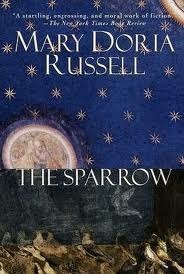
"He had…discovered the outermost limit of faith and, in doing so, had located the exact boundary of despair. It was at that moment that he learned, truly, to fear God."
THE SPARROW, Mary Doria Russell
Several years ago I was in an interfaith book club that read only spiritual books. Sadly, it dissolved as people moved on and away, but it was during that time that I had asked a dear priest friend of mine his favorite work of fiction, with strong faith elements. He replied, without hesitation, THE SPARROW, by Mary Doria Russell.
Father Michael, you must be nuts.
I forgot about the book until one of my blogger friends, Heather Johnson, recommended it to me. I bought it, couldn't put it down, and was depressed for weeks afterward.
And now, I have to recommend it to you.
It has taken me a month since reading it to figure out how to encourage you to read it when it made me so miserable, when yesterday, I saw someone write on Twitter that she enjoyed novels that made her miserable. I realized that in some sick way, I do, too. It's like a car accident–I can't look away.
I can't do justice to the elegance of prose, the depth of theme, and the complexity of the characters and their interactions in THE SPARROW because Russell is one of the finest writers of our generation. The reason I was so devastated by the novel was because of how much I loved the characters. I've never met a more "real" cast of people, and even though I knew from the first chapter that only one of them would make it back from a mission to another planet–and horribly scarred, physically and emotionally–I couldn't stop reading.
I haven't loved and felt this horrible after a book since THE ROAD, a novel set in post-apocalyptic America, where the burning question of the book is will the father have the courage (?) audacity (?) to shoot his son with their one bullet before he, himself, dies, so the boy is not left to roaming bands of meat-hungry cannibals?
If you haven't read it, you must.
And along this line of misery reading, I have to recommend THE HUNGER GAMES TRILOGY. I'm sure most of you have heard of it: it's LORD OF THE FLIES meets SURVIVOR on steroids. Teenagers from each district of another version of a post-apocalyptic U. S. battle to the death for one victor to win food and prizes for his or her impoverished home city. It's brutal and horrific and I couldn't put it down.
So, there you have it: a collection of books with high marks in writing, plot, character development, and devastation. Have you read any of these books? Do you enjoy reading books that make you miserable? Do you have any to add to the list?








November 15, 2011
Review: FALL OF GIANTS

Fall of Giants, by Ken Follett, was published in September of 2010 and is 985 pages. I am a huge fan of Follett and was thrilled to win this book from a giveaway at the Gutenberg Girls Blog. I was nervous to dive into this massive novel because I'd heard so many lukewarm reviews, but it is, without a doubt, my favorite Follett novel.
Fall of Giants begins with a six page cast of characters; it is, after all, Book One of a Century Triology. I found the cast pages too intimidating, so I dove right into the book at Chapter One. Within the first several pages I was thoroughly engrossed, and even after nearly one thousand pages, I never had to consult the six page character list.
Every character in the novel is distinct and fascinating, and represents a country or viewpoint of the world leading up to and through WWI. Most notably, but not exclusively, there are the working-class coal miners from Wales, the British aristocrats, the Russian nobility and peasantry, the militaristic upper class Germans, and the political Americans. The lives of the men and women from each level of society and every country are intertwined by work and love, and Follett brilliantly uses his characters to demonstrate how class warfare, passion, and pride led to the the first World War.
Follett is a master plotter. He keeps the reader riveted on every page of his thousand page novels because every single scene is full of tension, fascinating circumstances, memorable characters, and graphic detail. Nothing is spared, and you will flinch, cry, gasp, and blush many times throughout the novel. His prose is so vivid that it plays like a movie, and this will, I hope, become a series as his earlier novels have.
If you enjoy epic novels of love and war, I highly recommend Fall of Giants. My only complaint is that I have to wait until next fall to read the sequel.
For more on Ken Follett, visit his website at http://www.ken-follett.com/.








November 10, 2011
Steps Toward Simplicity
"If you find yourself bored or discontented, try this: Give your house a thorough cleaning. Get rid of everything you have no need for. Make your American house as uncluttered as a Japanese house. There is no better cure for the doldrums."
HOW TO BE AN AMERICAN HOUSEWIFE, Margaret Dilloway
It has been a rough couple of weeks.
I've been dealing with a neighbor dispute (the woman cut down fifteen of my 15 ft. green giant arbor vitae.) My friend's daughter has leukemia, and that is really hard to watch. (I can't imagine living it directly.) My mother is in poor health and won't get better.
While living in the shadow of these things, my capacity for patience and coping with the day-to-day complications and adventures of family life are diminished. Hectic schedules, coordinating family for get-togethers, watching the blocks on the calendar march at warp speed toward the holidays has been making me frantic.
Then there's my work, writing, which I LOVE and gives me the escape I crave, but which gets pushed aside and even neglected for day-to-day living. Blogs I want to read, workshops I want to attend, research I need to do get bumped from the to-do list, while I try to engage in conversations on social media, while cooking dinner, answering phone calls, and getting kids dressed for sports.
No, this, is not a first-world pity party; I'm getting to the point.
The quote above from Maragaret Dilloway's HOW TO BE AN AMERICAN HOUSEWIFE has been nudging me from my subconscious since I read it. It's interesting that the manual from the book of advice that seems somewhat dated and even primitive actually encompasses deep wisdom, and that wisdom is placing value on simplicity and mindfulness.
I should know better than to ever answer phone calls, check email, and help my kids with homework at the same time. I should know better than to let junk pile up in closets that I have to kick out of the way to find a simple pair of shoes. I should know better than to sign up for every social media venue because I think I should be building my platform as widely as possible. That's rubbish. Nothing is getting done well–or even at all–in these scenarios. All I'm doing is trying to stretch myself like a miniature rubber band across a vacation-full of mail.
So, since I have no control over the big, terrible things in my life, I started with this little book shelf.
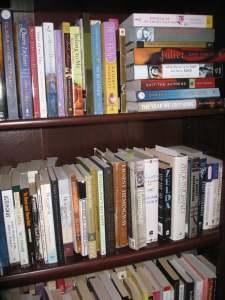
I know it still might look messy to you, but you should have seen the "before" shot. My "To Be Read" pile is now horizontal, the rest of the books are vertical. The research books are all together, organized by subject. I removed the books I did not want and gave them to a local charity. Now, when I walk past the shelves in my office, the book case disappears and rests in the comforting space of the room instead of screaming at me to organize it.
Next, I went up to my closet where I trip over summer flip flops and shoes I'll never wear again, to search through hangers of clothes I'll never wear again, in a mess of summer and winter frocks. I pulled everything out. Two hours later I had three bags of clothing for a local charity. I felt the knots loosen in my shoulders.
Then I went to Google + and deleted my account. I've hated that site since I signed up for it, but felt like I should. If Facebook implodes I can always start over with Google +, but honestly, I don't think that will happen. 90% of the circle notifications I received each day in my inbox were from creepy men looking for women, and I don't want those people to know what I'm up to.
I can't believe how profoundly the simplification of my environment has affected my well being, the quality of my interactions with my family, and the quality of my work. Nothing of substance in my life has changed, but by taking control of the parts of my life I can control, I can breathe again.
What about you? Have you ever had this experience? What did you do to de-clutter your life and breathe easier?








November 1, 2011
Review: Everything Beautiful Began After
"Language is like drinking from one's own reflection in still water. We only take from it what we are at that time."
Everything Beautiful Began After, Simon Von Booy
Everything Beautiful Began After by Simon Van Booy was published in July of 2011. After discussing my love of F. Scott Fitzgerald and Ernest Hemingway with several people at independent book store, One More Page, in Arlington, VA, I was hand-sold this book. I am not exaggerating when I tell you that this novel may have unseated Possession by A. S. Byatt as my favorite book of all time.
The novel takes place largely in Athens, Sicily, and France, but spans many continents and time periods, and is divided into the time before and after an event. Before the event, in Athens, Greece, three people's lives converge in unexpected ways as they are all displaced in some way from a life they should be living, where they reside under the cover of shadows from their pasts or demons from their present.
Rebecca, an artist, still feels the hollow wound of her mother's abandonment of her and her twin sister when they were children. George, a linguist and American boarding school graduate, drinks to anesthetize himself from his loneliness. Henry, an archaeologist, is trapped in a tragedy from his past that has never allowed him to fully live.
The three of them meet each other in the decaying city of Athens and begin to emerge from their vacancies until a terrible incident changes everything. Though their worlds are shaken, the experience leads to true spiritual awakening and appreciation for the tragic beauty of every moment in life.
I knew from the moment I started Everything Beautiful Began After that I was in love. I had to remind myself to breathe after the first chapter, not because of any jarring scenes or shocking moments (those come later), but because of the language. This novel feels like 402 pages of poetry, without a single gratuitous word. Every sentence has weight, but rather than being exhausting, the reading is exhilarating. I underlined half of the sentences in the book, and I know I will reread it many times.
In addition to the elegant prose, there are several point of view shifts in the novel, not only from character to character but also from third to second person, that support both the thematic and character development. There are also many drawings, post cards and letters embedded within the text that enhance the authenticity of the story.
Everything Beautiful Began After is literary, philosophical, and spiritually rich but it is also very accessible, which makes it genius. This is a book club book, and as it was recommended to me, I suggest to you that you read this book on paper. An e-reader can't possibly do its text features justice. This is a book you'll want on your shelf to refer to and display so that people thumbing through your library can pick it up and get lost in it.
I can't do justice to the perfection of this novel. I want to call it a religious experience, but I'm afraid I'll sound ridiculous or build it up too much for you. I will say that Everything Beautiful Began After profoundly touched me. It is a book I will carry with me and recommend widely. Please read it and tell me what you think.




 [image error]
[image error]
 [image error]
[image error]
October 28, 2011
Review: HOW TO BE AN AMERICAN HOUSEWIFE
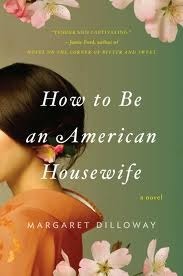
HOW TO BE AN AMERICAN HOUSEWIFE by Margaret Dilloway was published in August of 2010 and is 288 pages. I bought it because I went on a writing retreat with Margaret last weekend, and I wanted to read books by the women in attendance. I had also heard many great things about the book from several blogs and on Twitter so I was eager to read it.
Set in multiple time periods in Japan and in the United States, HOW TO BE AN AMERICAN HOUSEWIFE is a touching and poignant tale of a mother and daughter, and how the past shaped and defined their future. Shoko, the Japanese mother, narrates the first half of the book, and Sue, her half-American daughter narrates the second half. Both women have unique, compelling voices.
As a girl, Shoko often found herself in trouble for disobedience and nonconformity. She was very close with her brother, Taro, but her choices in love, culminating with her marriage to an American serviceman, destroy their relationship. Many years pass, and as Shoko deals with aging and her failing health, she reflects on her life and her regrets. Her greatest wish is to return to Japan to make peace with her brother before she dies. Little does she know, her quest to reach out to her family will heal wounds with her own children and free them from burdens they didn't even realize they carried.
There were so many reasons to love this book. Shoko is a memorable, unique character. She is feisty, abrupt, and honest, and her reflections on the people around her made me laugh and cry. The dialect was extremely well-written–always supporting the characters and settings and flowing naturally within the text. I also enjoyed how the different settings and times blended so well. Dilloway's movement from past to present, and character to character was seamless.
Above all of this, I loved that the novel had such a message of hope and forgiveness. Family sagas can be difficult because each reader often has her own baggage and stories that shadow the reading. Dilloway depicts how generations can save each other, and her message is one that makes this debut novel truly excellent.
I highly recommend HOW TO BE AN AMERICAN HOUSEWIFE.
For more on Margaret Dilloway, visit her website at http://margaretdilloway.com/



 [image error]
[image error]



October 11, 2011
Review: Dogtown: Death and Enchantment in a New England Ghost Town
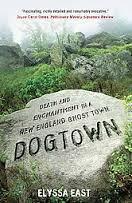
"There is a style of Japanese calligraphy called zuihitsu, which translates literally as 'follow the brush.' In zuihitsu the calligrapher surrenders to the brush rather than consciously trying to control it, allowing the brush to tell its own story. Inevitably, the brushwork becomes both the journey and the destination." Elyssa East, DOGTOWN: DEATH AND ENCHANTMENT IN A NEW ENGLAND GHOST TOWN
Elyssa East's DOGTOWN was published in 2009 and is 304 pages. I heard about the book on Twitter. Because October evokes a Poe sensibility in me, I find myself gravitating toward darker reads this time of year. DOGTOWN satisfied that urge and much more than I could have anticipated.
Set in the past and present in a wood just outside of Gloucester, Massachusetts, DOGTOWN tells the history of a strange and haunted forest where centuries of unusual and downright awful incidents–from witchcraft, to suicides, to murder–have stained the rocky landscape. In spite of the dark past of Dogtown, however, there remains a wild beauty and almost mythic energy present in the land that has inspired painters, poets, and conservationists for generations.
Elyssa East tells of her initial sojourn to Dogtown as the explorations of an art student interested in finding creative stimulation in the landscape that was the subject of a series of paintings by Marsden Hartley. Like the Japanese calligrapher's brush, a warning on a book shop map and the foreboding comments of a waitress lead East to the stories trying to claw their way out of the rocky, shadowed paths of that strange forest and into places she never could have expected to venture.
DOGTOWN is one of those rare books that can be read on many levels and enjoyed by many kinds of readers. For those looking for a true crime story, East delivers a riveting and chilling story of the 1984 murder of a local woman that forever taints the footpaths of Dogtown. For lovers of history, East reports on centuries of the social and political development of Dogtown and the surrounding areas. For artists and writers, East presents a thought-provoking narrative on the influence of place and time, what draws us to other artists, and how art begets art.
What is most impressive about DOGTOWN is how well East balances detail and story, and weaves together all of the aspects of the book with seamless balance and transition. Her elegance of language and the way she moves from history to the present day kept me turning pages long into the night, even when I was frightened by what I was reading.
If you enjoy intense narrative nonfiction, I give DOGTOWN my highest recommendation. If you've read it, I'd love to know what you think.

